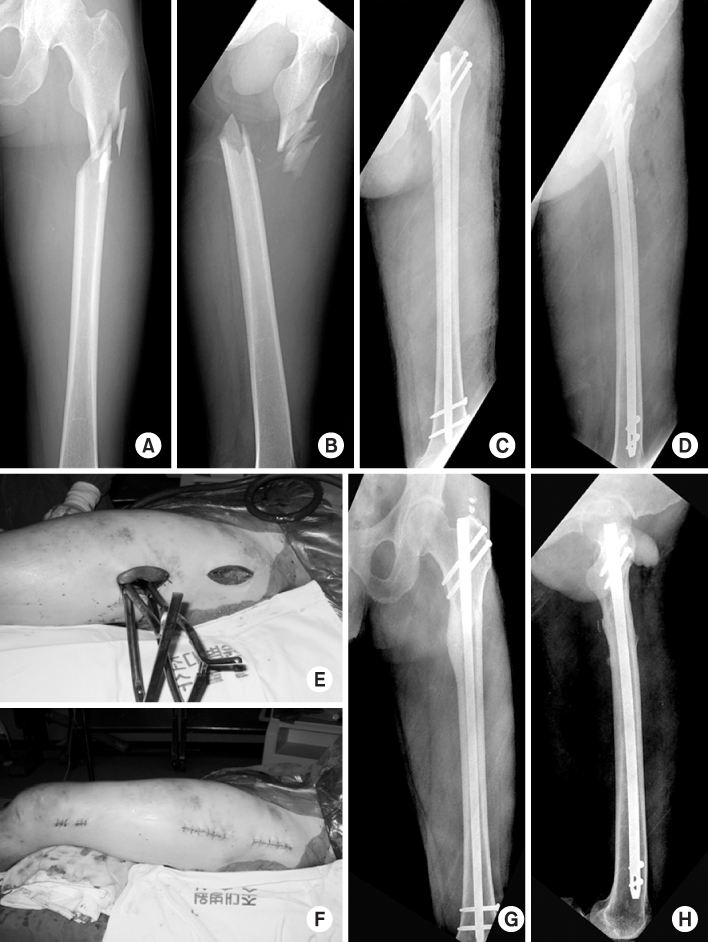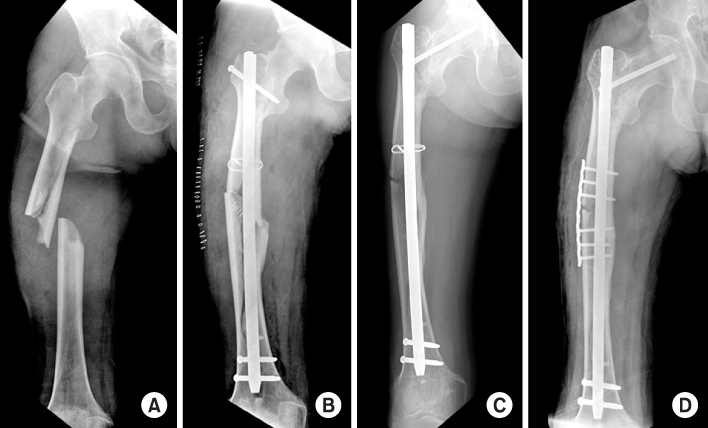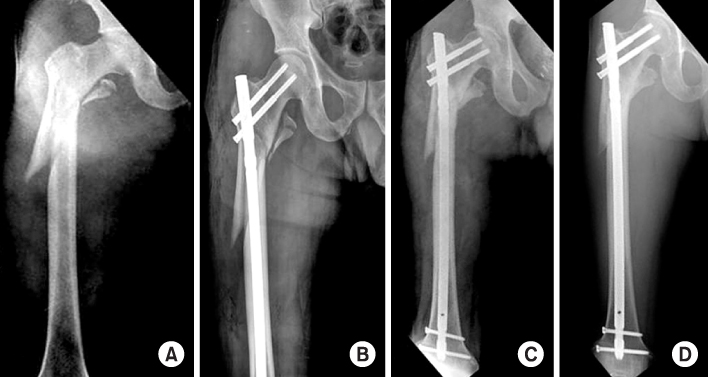Articles
- Page Path
- HOME > J Musculoskelet Trauma > Volume 22(4); 2009 > Article
-
Original Article
- Limited Open Reduction and Intramedullary Nailing of Proximal Femoral Shaft Fracture
- Sang Ho Ha, M.D., Jun Young Lee, M.D., Sang Hong Lee, M.D., Sung Hwan Jo, M.D., Jae Cheul Yu, M.D.
-
Journal of the Korean Fracture Society 2009;22(4):225-231.
DOI: https://doi.org/10.12671/jkfs.2009.22.4.225
Published online: October 30, 2009
Department of Orthopaedic Surgery, College of Medicine, Chosun University, Gwangju, Korea.
- Address reprint requests to: Jun-Young Lee, M.D. Department of Orthopaedic Surgery, Chosun University Hospital, 588, Seosuk-dong, Dong-gu, Gwangju 501-717, Korea. Tel: 82-62-220-3147, Fax: 82-62-226-3379, leejy88@chosun.ac.kr
Copyright © 2009 The Korean Fracture Society. All rights reserved.
This is an Open Access article distributed under the terms of the Creative Commons Attribution Non-Commercial License (http://creativecommons.org/licenses/by-nc/3.0/) which permits unrestricted non-commercial use, distribution, and reproduction in any medium, provided the original work is properly cited.
- 506 Views
- 2 Download
Abstract
-
Purpose
- To evaluate the result of treatment of proximal femoral shaft fracture with limited open reduction and intramedullary nailing.
-
Materials and Methods
- Fifteen patients who had limited open reduction and intramedullary nailing due to proximal femoral shaft fracture for follow-up for more than 12 months were selected between March 2001 and December 2005. The clinical and radiologic results were analyzed. Winquist-Hansen classification and OTA/AO classification were used.
-
Results
- Thirteen cases achieved bone union and 2 cases showed delayed union. The mean bone union period was 21.3 weeks (14~32). There was no postoperative infection. Nonunion was observed in 2 cases of which bone union was acquired with the exchange of intramedullary nail and bone graft in one case and with the additional plate fixation and bone graft in the other case.
-
Conclusion
- Treating proximal femoral shaft fracture with limited open reduction and intramedullary nailing seems to be a technique to manage proximal femoral shaft fracture that has combined fracture or ipsilateral femoral fracture or is unable to acquire acceptable reduction with closed reduction.
- 1. Bajwa AS, Schnaid E. Current indicaitons for open femoral intramedullary kuntscher nail. J Bone Joint Surg Br, 1998;80:163.
- 2. Bohler L, Bohler J. Kütscher's medullary nailing. J Bone Joint Surg Am, 1949;31A:295-305.
- 3. Champoux JA, Chandler RS. Fractures of the femoral shaft : Closed or open nailing. 1983.Unpublished data.
- 4. Fracture and dislocation compendium. Orthopaedic Trauma Association Committee for Coding and Classification. J Orthop Trauma, 1996;10:1-154.
- 5. Gregory P, DiCicco J, Karpik K, DiPasquale T, Herscovici D, Sanders R. Ipsilateral fractures of the femur and tibia: treatment with retrograde femoral nailing and unreamed tibial nailing. J Orthop Trauma, 1996;10:309-316.Article
- 6. Grover J, Wiss DA. A prospective study of fractures of the femoral shaft treated with a static, intramedullary, interlocking nail comparing one versus two distal screws. Orthop Clin North Am, 1995;26:139-146.Article
- 7. Hansen JR, Sigvard , Wingnest RA. Closed intramedullary nailing of fracture of femoral shaft:technical consideration. I.C.L., 1978;XXVII:90-108.
- 8. Harper MC. Fractures of the femur treated by open and closed intramedullary nailing using the fluted rod. J Bone Joint Surg Am, 1985;67:699-708.Article
- 9. Jaarsma RL, Pakvis DFM, Verdonschot N, Biert J, van Kampen A. Rotational malignment after intramedullary nailing of femoral fractures. J Orthop Trauma, 2004;18:403-409.
- 10. Johnson KD, Johnston DW, Parker B. Comminuted femoral shaft fractures: treatment by roller traction, cerclage wires and an intramedullary nail, or an intralocking intramedullary nail. J Bone Joint Surg Am, 1984;66:1222-1235.
- 11. Kang S, Chung PH, Chae DJ, et al. Nail breakage after femoral interlocking intramedullary nailing. J Korean Soc Fract, 2002;15:363-370.Article
- 12. Karpos PA, McFerran MA, Johnson KD. Intramedullary nailing of acute femoral shaft fractures using manual traction without a fracture table. J Orthop Trauma, 1995;9:57-62.Article
- 13. Kempf I, Grosse A, Beck G. Closed locked intramedullary nailing. Its application to comminuted fractures of the femur. J Bone Joint Surg Am, 1985;67:709-720.Article
- 14. Kim SS, Sohn SK, Kim CH, Lee MJ, Wang L. Cause and treatment of the nonunion of femoral shaft fracture after interlocking intramedullary nailing. J Korean Fract Soc, 2007;20:141-148.Article
- 15. Klemm KW, Börner M. Interlocking nailing of complex fracture of femur and tibia. Clin Orthop Relat Res, 1986;212:89-100.
- 16. Küntscher G. Intramedullary surgical technique and its place in orthopaedic surgery. J Bone Joint Surg Am, 1965;47:809-818.Article
- 17. Lauro MA Jr, Camilo VT, Fortune DC. Delayed open intramedullary nailing of femoral shaft fractures. Tech Orthop, 2006;21:88-98.Article
- 18. Lee EW, Kang SY, Chang EC, Kim IS. Closed intramedullary nailing of femoral fracture without a fracture table. J Korean Orthop Assoc, 1995;30:1713-1717.ArticlePDF
- 19. Majkowski RS, Baker AS. Interlocking nails for femoral fractures: an initial experience. Injury, 1991;22:93-96.Article
- 20. Ricci WM, Bellabarba C, Lewis R, et al. Angular malalignment after intramedullary nailing of femoral shaft fractures. J Orthop Trauma, 2001;15:90-95.Article
- 21. Sanders R, Koval KJ, DiPasquale T, Helfet DL, Frankle M. Retrograde reamed femoral nailing. J Orthop Trauma, 1993;7:293-302.Article
- 22. Shin DE, Lee DH, Ahn CS, Nam KS. The shortening and rotational deformity after closed intramedullary nailing of femur shaft fracture: according to Winquist-Hansen classification. J Korean Fract Soc, 2007;20:297-301.Article
- 23. Swiontkowski MF, Hansen ST Jr, Kellam J. Ipsilateral fractures of the femoral neck and shaft. A treatment protocol. J Bone Joint Surg Am, 1984;66:260-268.Article
- 24. Thoresen BO, Alho A, Ekeland A, Strømsøe K, Follerås G, Haukebø A. Interlocking intramedullary nailing in femoral shaft fractures. A report of forty-eight cases. J Bone Joint Surg Am, 1985;67:1313-1320.Article
- 25. Tornetta P 3rd, Tiburzi D. The treatment of femoral shaft fractures using intramedullary interlocked nails with and without intramedullary reaming: a preliminary report. J Orthop Trauma, 1997;11:89-92.Article
- 26. Webb LX, Gristina AG, Fowler HL. Unstable femoral shaft fractures: a comparison of interlocking nailing versus traction and casting methods. J Orthop Trauma, 1988;2:10-12.
- 27. Winquist RA, Hansen ST Jr. Comminuted fractures of the femoral shaft treated by intramedullary nailing. Orthop Clin North Am, 1980;11:633-648.Article
- 28. Winquist RA, Hansen ST Jr, Clawson DK. Closed intramedullary nailing of femoral fractures. A report of fire hundred and twenty cases. J Bone Joint Surg Am, 1984;66:529-538.
- 29. Wiss DA, Brien WW, Stetson WB. Interlocked nailing for treatment of segmental fractures of the femur. J Bone Joint Surg Am, 1990;72:724-728.Article
- 30. Wiss DA, Fleming CH, Matta JM, Clark D. Comminuted and rotationally unstable fractures of the femur treated with an interlocking nail. Clin Orthop Relat Res, 1986;212:35-47.Article
- 31. Wolinsky PR, McCarty EC, Shyr Y, Johnson KD. Length of operative procedures: reamed femoral intramedullary nailing performed with and without a fracture table. J Orthop Trauma, 1998;12:485-495.Article
REFERENCES



Figure & Data
REFERENCES
Citations




Fig. 1
Fig. 2
Fig. 3
Demographics of patients treated with limited open reduction and intramedullary nailing of proximal femoral shaft fracture
*W-H: Winquist and Hansen classification of fracture comminution, †MVA: Motor vehicle accident.
*W-H: Winquist and Hansen classification of fracture comminution, †MVA: Motor vehicle accident.

 E-submission
E-submission KOTA
KOTA TOTA
TOTA TOTS
TOTS

 Cite
Cite

